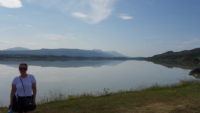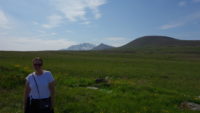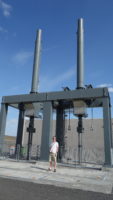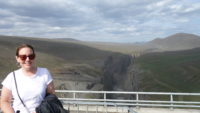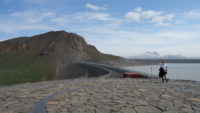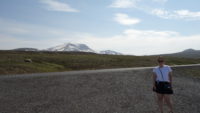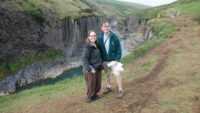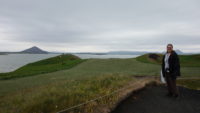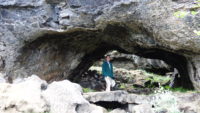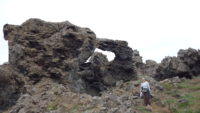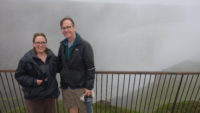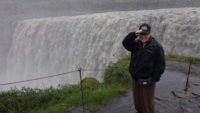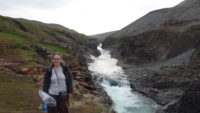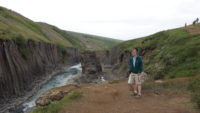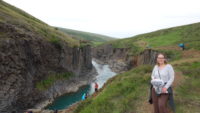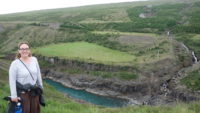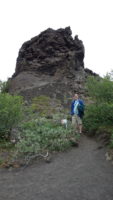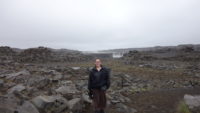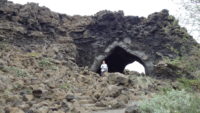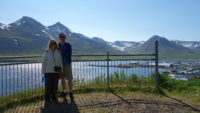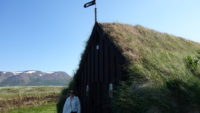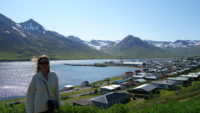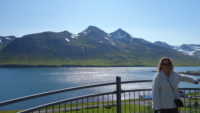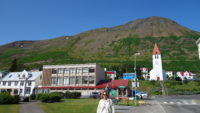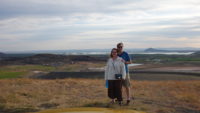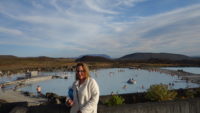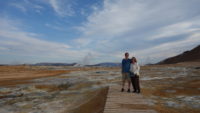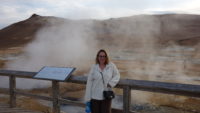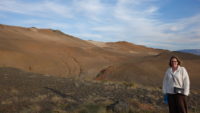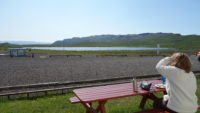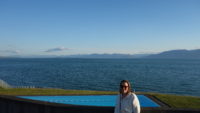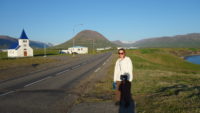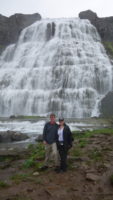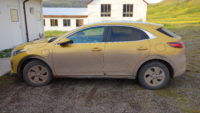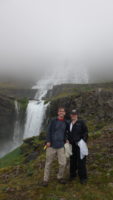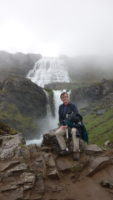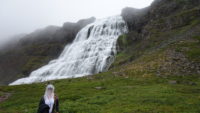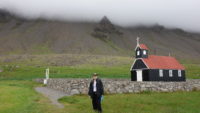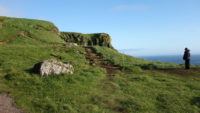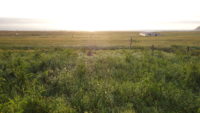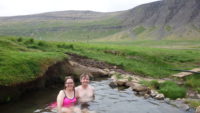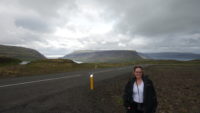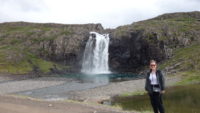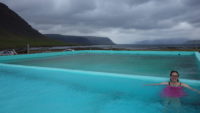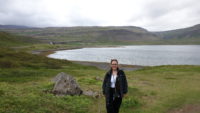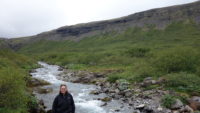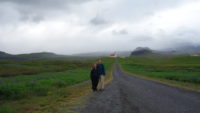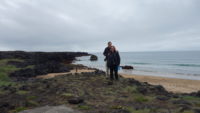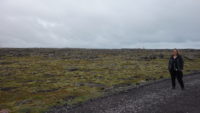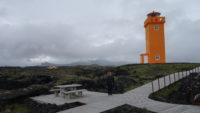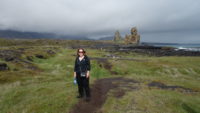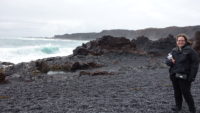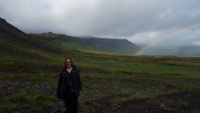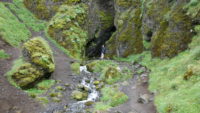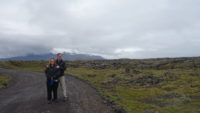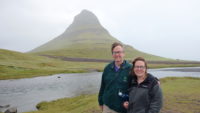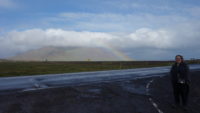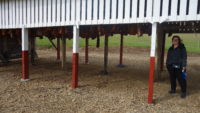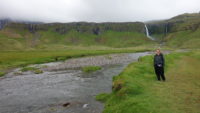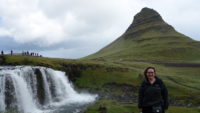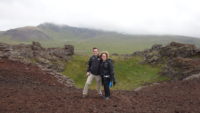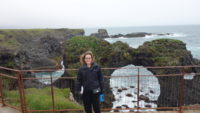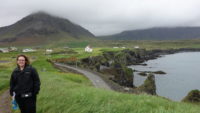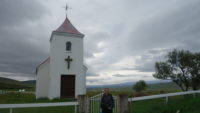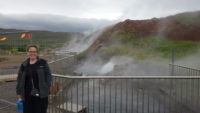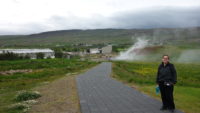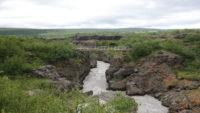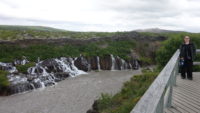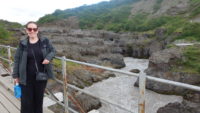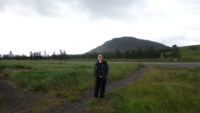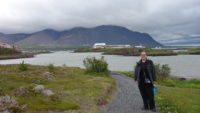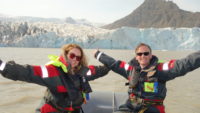 Meredith has a travel axiom – you will waste some time or some money when you travel, and it is best not to fret too much over it. Due to a map error in our guidebook that mistakenly placed our cabin near a sight I wanted to see, I ended up wasting an hour of driving today on top of a long driving day already. These things happen, and it was still a good day.
Meredith has a travel axiom – you will waste some time or some money when you travel, and it is best not to fret too much over it. Due to a map error in our guidebook that mistakenly placed our cabin near a sight I wanted to see, I ended up wasting an hour of driving today on top of a long driving day already. These things happen, and it was still a good day.
Today was not a “the journey is the destination” day. I wanted to get us to Iceland’s south coast region as quickly as I could. It was still amazingly scenic – we drove in and out of at least half a dozen fjords, and there were many places begging for a photo stop. I pressed on, with only two bathroom stops over six hours. But we made it in time.
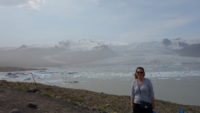 I had been aiming for the Fjallsarlon glacier lagoon. It is the smaller of two lagoons in the area, formed by the retreating Vatnajokull glacier. Being the smaller lagoon, it is far less crowded than the bigger and better-known (and tour bus stop) Jokulsarlon lagoon. Moreover, the Fjallsarlon location had boat tours on a more intimate scale (since the lagoon is smaller), getting you up close to the icebergs in the lagoon as well as to the glacier face. We got there a little before 3:00 and got booked on a 3:30 boat. We wandered up to a viewpoint over the water to fill up the time, and then headed back to get suited up.
I had been aiming for the Fjallsarlon glacier lagoon. It is the smaller of two lagoons in the area, formed by the retreating Vatnajokull glacier. Being the smaller lagoon, it is far less crowded than the bigger and better-known (and tour bus stop) Jokulsarlon lagoon. Moreover, the Fjallsarlon location had boat tours on a more intimate scale (since the lagoon is smaller), getting you up close to the icebergs in the lagoon as well as to the glacier face. We got there a little before 3:00 and got booked on a 3:30 boat. We wandered up to a viewpoint over the water to fill up the time, and then headed back to get suited up.
For safety reasons, you have to wear a jacket that keeps you warm should you fall in the water, and over that is a lifejacket that inflates on contact with water. Since the tour takes place in an inflatable craft where you sit on the rim of the boat, these are good precautions. (We didn’t fall in.)
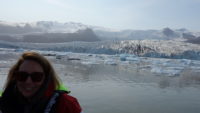 There were eleven of us on the boat – eight adults and three older children, and then the pilot. He was both informative and amusing. He passed on that the boat was as unsinkable as the Titanic, and we would be fully safe as long as we saw no icebergs. He also told us there are three main colors of icebergs – blue, for ones newly calved from the glacier; white for any iceberg older than a day old; and dirty ones that scraped the mountains along the way down. Blue icebergs are blue because they are dense from being compressed during the five-hundred-year journey to the lagoon. When those start to melt (within a day), air gets absorbed into the surface ice, which makes them look white.
There were eleven of us on the boat – eight adults and three older children, and then the pilot. He was both informative and amusing. He passed on that the boat was as unsinkable as the Titanic, and we would be fully safe as long as we saw no icebergs. He also told us there are three main colors of icebergs – blue, for ones newly calved from the glacier; white for any iceberg older than a day old; and dirty ones that scraped the mountains along the way down. Blue icebergs are blue because they are dense from being compressed during the five-hundred-year journey to the lagoon. When those start to melt (within a day), air gets absorbed into the surface ice, which makes them look white.
The trip was thrilling to me – not like anything I had ever done before. To my recollection, I have never been in an inflatable boat, let alone one surrounded by icebergs. We started out and headed toward where the ice had drifted back toward the glacier (the wind was blowing that way for much of the day). I was disappointed that the ice formed a solid mass and there did not seem to be a way through. Our pilot told us to hold on and rammed up on a small iceberg, which was especially exciting to me and Meredith, since we were sitting in the prow of the boat. With the nose of the craft beached on the iceberg, the guide simply used the boat to move it out of the way, since the ice was floating. We did that trick a few times in different places.
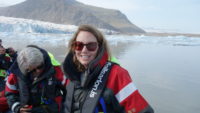 We weaved in and out of ice packs, making our way closer to the glacier wall. At one point, when the boat was stopped so we could take photos of an iceberg, the glacier let out a “boom” and calved a small iceberg. I didn’t see the ice falling, but I looked over in time to see the water splashing up and some ice fragments hanging in the air.
We weaved in and out of ice packs, making our way closer to the glacier wall. At one point, when the boat was stopped so we could take photos of an iceberg, the glacier let out a “boom” and calved a small iceberg. I didn’t see the ice falling, but I looked over in time to see the water splashing up and some ice fragments hanging in the air.
We got quite close to the glacier, but kept a safe distance. The guide fished out a small chunk of ice so we could hold five-hundred-year-old ice and get our pictures with it. He said it is pure ice and goes great with whiskey.
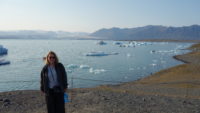 The entire tour lasted about forty-five minutes and was an amazing experience. We got out of our gear, and Meredith and I hurried to the cafe. It was 4:50, and they closed at 5:00, and there are no towns within fifty miles of the lagoons, so this was our only eating option we knew about. We grabbed the last two sandwiches that they had, and that was supper. Meredith commented that never before has she been so unsure of getting meals while touring Europe.
The entire tour lasted about forty-five minutes and was an amazing experience. We got out of our gear, and Meredith and I hurried to the cafe. It was 4:50, and they closed at 5:00, and there are no towns within fifty miles of the lagoons, so this was our only eating option we knew about. We grabbed the last two sandwiches that they had, and that was supper. Meredith commented that never before has she been so unsure of getting meals while touring Europe.
I wanted to go check into our room, which looked to be about ten minutes away on our map. Then we could return to see the big lagoon. The guesthouse turned out to be about thirty minutes away – the map had the location wrong. That meant thirty minutes there, checking in, and then thirty minutes back to where we had just come from. Mistakes happen sometimes when you travel.
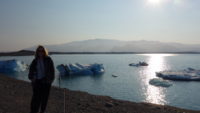 We did get back to Jokulsarlon, and we loved it. It is much bigger than the other lagoon, and the icebergs are huge. We both agreed the smaller lagoon has much more ice, but the ice that Jokulsarlon has is big. The sun was also low(ish) on the horizon, so the water and ice were glinting in the low sunlight. There were still a lot of people around, but not nearly so many as the parking lot could hold (and no buses). It was a quiet place of beauty, except for the two booms of distant calving that happened while we were there. We were too far away from the glacier to see anything, but you sure could hear it.
We did get back to Jokulsarlon, and we loved it. It is much bigger than the other lagoon, and the icebergs are huge. We both agreed the smaller lagoon has much more ice, but the ice that Jokulsarlon has is big. The sun was also low(ish) on the horizon, so the water and ice were glinting in the low sunlight. There were still a lot of people around, but not nearly so many as the parking lot could hold (and no buses). It was a quiet place of beauty, except for the two booms of distant calving that happened while we were there. We were too far away from the glacier to see anything, but you sure could hear it.
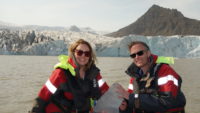 After a quick look across Route 1 to see where the river dumps the icebergs into the sea, we headed home for the evening. It was an early turn-in for us (8:30), but we have been touring hard and long for a few days now. Sometimes getting rest is not wasting time.
After a quick look across Route 1 to see where the river dumps the icebergs into the sea, we headed home for the evening. It was an early turn-in for us (8:30), but we have been touring hard and long for a few days now. Sometimes getting rest is not wasting time.
